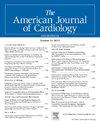自发性冠状动脉夹层(SCAD)患者的冠外动脉病理。
IF 2.1
3区 医学
Q2 CARDIAC & CARDIOVASCULAR SYSTEMS
引用次数: 0
摘要
背景/目的:自发性冠状动脉剥离(SCAD)越来越被认为是急性冠状动脉综合征的一个原因,并与冠状动脉外病变有关,如纤维肌肉发育不良(FMD)、动脉瘤和跨其他血管床的剥离。然而,这些关联在文献中仍未得到充分研究。本研究旨在描述大队列SCAD患者冠状动脉外病变的患病率和分布。方法:选取2018-2024年诊断为SCAD的患者。收集基线特征和合并症。可用的血管成像,包括超声心动图、计算机断层扫描和磁共振,用于评估冠状动脉外病变。记录了FMD、动脉瘤和冠状外血管床夹层的患病率和位置。结果:在1380例SCAD患者中,564例(40.9%)发现FMD, 166例(12.0%)发现冠状动脉外夹层,228例(16.5%)在至少一个冠状动脉外血管床上发现动脉瘤。FMD最常见的部位是肾动脉、颈动脉、椎动脉和髂/股动脉。动脉瘤最常见于脑动脉、颈动脉、肾动脉和脾动脉。颈动脉、椎动脉、四肢动脉和腹腔动脉夹层最为常见。胸主动脉瘤罕见,仅有4例出现胸主动脉夹层。结论:冠状动脉外病变在SCAD患者中很普遍,影响了超过47%的队列。这些发现强调了对SCAD患者进行全面血管成像以检测冠状动脉外血管异常的重要性,这可能对监测和管理策略有影响。本文章由计算机程序翻译,如有差异,请以英文原文为准。
Extracoronary Arterial Pathologies in Patients With Spontaneous Coronary Artery Dissection
Spontaneous coronary artery dissection (SCAD) is increasingly recognized as a cause of acute coronary syndrome and has been associated with extracoronary arteriopathies, such as fibromuscular dysplasia (FMD), aneurysms, and dissections across other vascular beds. However, these associations remain understudied in the literature. This study aims to characterize the prevalence and distribution of extracoronary arteriopathies in a large cohort of SCAD patients. Patients diagnosed with SCAD were extracted from 2018 to 2024. Baseline characteristics and comorbidities were collected. Available vascular imaging, including echocardiograms, computed tomography, and magnetic resonance, were used to assess for extracoronary arteriopathies. The prevalence and location of FMD, aneurysms, and dissections in extracoronary vascular beds were documented. Among 1,380 SCAD patients, 564 (40.9%) were found to have FMD, 166 (12.0%) had extra-coronary arterial dissections, and 228 (16.5%) had aneurysms in at least 1 extracoronary vascular bed. The most common sites of FMD were renal, carotid, vertebral, and iliac/femoral arteries. Aneurysms were most frequently located in cerebral, carotid, renal, and splenic arteries. Dissections were most prevalent in the carotid, vertebral, extremity, and celiac arteries. Thoracic aortic aneurysms were rare, with only 4 patients showing thoracic aortic dissection. Extracoronary arteriopathies are prevalent in patients with SCAD, affecting more than 47% of the cohort described here. These findings underscore the importance of comprehensive vascular imaging in patients with SCAD to detect extracoronary vascular abnormalities, which may have implications for surveillance and management strategies.
求助全文
通过发布文献求助,成功后即可免费获取论文全文。
去求助
来源期刊

American Journal of Cardiology
医学-心血管系统
CiteScore
4.00
自引率
3.60%
发文量
698
审稿时长
33 days
期刊介绍:
Published 24 times a year, The American Journal of Cardiology® is an independent journal designed for cardiovascular disease specialists and internists with a subspecialty in cardiology throughout the world. AJC is an independent, scientific, peer-reviewed journal of original articles that focus on the practical, clinical approach to the diagnosis and treatment of cardiovascular disease. AJC has one of the fastest acceptance to publication times in Cardiology. Features report on systemic hypertension, methodology, drugs, pacing, arrhythmia, preventive cardiology, congestive heart failure, valvular heart disease, congenital heart disease, and cardiomyopathy. Also included are editorials, readers'' comments, and symposia.
 求助内容:
求助内容: 应助结果提醒方式:
应助结果提醒方式:


